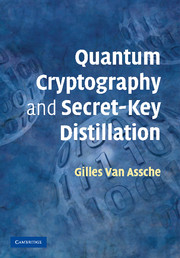Book contents
- Frontmatter
- Contents
- Foreword
- Preface
- Acknowledgments
- 1 Introduction
- 2 Classical cryptography
- 3 Information theory
- 4 Quantum information theory
- 5 Cryptosystems based on quantum key distribution
- 6 General results on secret-key distillation
- 7 Privacy amplification using hash functions
- 8 Reconciliation
- 9 Non-binary reconciliation
- 10 The BB84 protocol
- 11 Protocols with continuous variables
- 12 Security analysis of quantum key distribution
- Appendix symbols and abbreviations
- Bibliography
- Index
2 - Classical cryptography
Published online by Cambridge University Press: 04 August 2010
- Frontmatter
- Contents
- Foreword
- Preface
- Acknowledgments
- 1 Introduction
- 2 Classical cryptography
- 3 Information theory
- 4 Quantum information theory
- 5 Cryptosystems based on quantum key distribution
- 6 General results on secret-key distillation
- 7 Privacy amplification using hash functions
- 8 Reconciliation
- 9 Non-binary reconciliation
- 10 The BB84 protocol
- 11 Protocols with continuous variables
- 12 Security analysis of quantum key distribution
- Appendix symbols and abbreviations
- Bibliography
- Index
Summary
Following its etymology, the term cryptography denotes the techniques used to ensure the confidentiality of information in its storage or transmission. Besides confidentiality, cryptography also encompasses other important functions such as authentication, signature, non-repudiation or secret sharing, to name just a few.
The purpose of this section is to give a short introduction to classical cryptography, but only for areas that are relevant to quantum cryptography. For our purposes, we will only deal with confidentiality and authentication. The former is the most important function that quantum key distribution helps to achieve, while the latter is a requirement for quantum key distribution to work. Also, we will cover some topics on the security of classical cryptographic schemes so as to give some insight when comparing classical and quantum cryptography.
The study of cryptography ranges from the analysis of cryptographic algorithms (or primitives) to the design of a solution to a security problem. A cryptographic algorithm is a mathematical tool that provides a solution to a very specific problem and may be based on premises or on other primitives. A solution can be designed by combining primitives, and the requirements and functions of the primitives have to be combined properly.
We will first review the confidentiality provided by ciphers that use the same key for both encryption and decryption, hence called secret-key ciphers. Then, we will discuss authentication techniques. Finally, we will show some aspects of public-key cryptography.
- Type
- Chapter
- Information
- Quantum Cryptography and Secret-Key Distillation , pp. 15 - 34Publisher: Cambridge University PressPrint publication year: 2006

